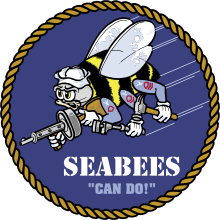The U.S. Navy Seabees are celebrating their 79th birthday Friday, March 5.
Rear. Adm. John Korka, Commander, Naval Facilities Engineering Systems Command/Chief of Civil Engineers, and Force Master Chief Delbert Terrell, Jr., Force Master Chief of the Seabees paid tribute to the Seabees in a new video. Watch it below:
The Seabees, or U.S. Naval Construction Battalions, were founded in 1942 when then Rear Adm. Ben Moreell saw a need for a militarized construction force. Moreell was chief of the Bureau of Yards and Docks at the time.
The U.S. Navy tweeted, “Happy Birthday to the #USNavy Seabees! Get an inside look at what the United States Navy Construction Battalion has been doing for the 79 years of its existence! From construction to combat training, this force can do it all!” with a link to a short documentary “Life As A Seabee.”
On Thursday, the Seabee Memorial Scholarship Associated tweeted, “Happy 79th Birthday Seabees! #Seabee #USNavy #NavySeabee.”
While the Seabees’ job entails construction, they can also be called on to fight, either accompanying another branch or in defense of their construction projects in the field.
The Seabees were formed after the attack on Pearl Harbor, and are part of the Naval Construction Force under the U.S. Navy.

Today, there are two Naval Construction Groups, two Construction Battalion Maintenance Units, four Naval Construction Regiments, two Underwater Construction Teams and 11 Naval Construction Battalions.
Their nickname “Seabees” comes from the first initials of their formal name, Construction Battalions – or “C” and “B.”
Naval Construction Group One is based in at Naval Base Ventura County (NBVC) in Port Hueneme, Calif.
According to the Navy: “NBVC provides airfield, seaport and base support services to fleet operating forces and shore activities, offering a unique combination of mission capabilities to the Navy and the Department of Defense. NBVC and its tenants directly employ more than 19,000 military and civilian personnel and is the largest employer in Ventura County. Located near Ventura on the California Coast, the area enjoys mild year-around temperatures. The climate is mild during summer when temperatures tend to be in the 60’s and cool during winter when temperatures tend to be in the 50’s. The warmest month of the year is August with an average maximum temperature of 73, while the coldest month of the year is December with an average minimum temperature of 45.”
Naval Construction Group Two is an Echelon IV command reporting to Navy Expeditionary Combat Command (NECC). It also serves as administrative Immediate Superior in Command (ISIC) for Active and Reserve Atlantic Naval Construction Forces (NCF).
According to the Navy:
NCG 2 includes an organic, embedded deployable Battle Staff (22 NCR) capable of executing combat service support missions across the spectrum of joint and combined environments while providing command and control (C2) over NECC units operating in a specific military operation.
The role of the NCG is to organize, man, train, maintain, and equip Naval Construction Regiments (NCRs), Naval Mobile Construction Battalions (NMCBs), the Construction Battalion Maintenance Unit (CBMU), the Underwater Construction Team (UCT), and Expeditionary Combat Camera to provide supported commanders with expeditionary engineering forces capable of general engineering and construction, and limited combat engineering across the full range of military operations.
The NCGs also provide the required engineering support our Navy and nation needs to construct and maintain base facilities, to repair battle damaged facilities, to conduct defensive operations as required, and to meet disaster preparedness and recovery missions.
NCGs provide Administrative Control (ADCON) oversight of Seabee forces as well.
The Navy’s oldest systems command is the Naval Facilities Engineering Command, formed in 1842. The Navy Civil Engineers Corps was formed in 1867 after the Civil War.
“Happy 79th Birthday to the U.S. Navy #Seabees!,” tweeted U.S. Naval History. “As we honor the Construction Battalion today, we’ve put together a list of 10 things that you need to know about your U.S. Navy Seabees. Click the link below to read the blog and tag a Seabee!”



